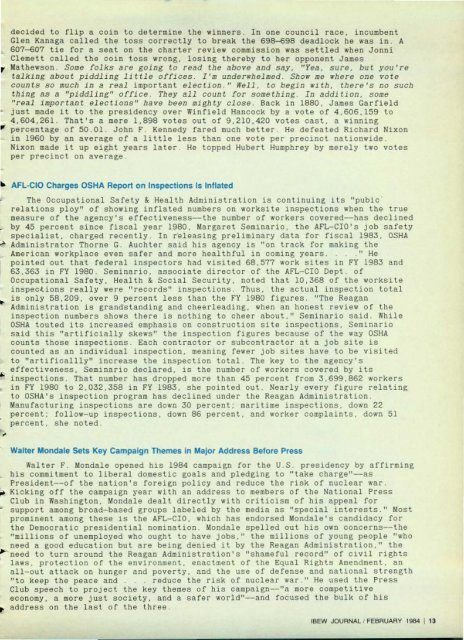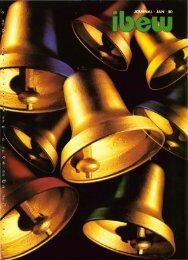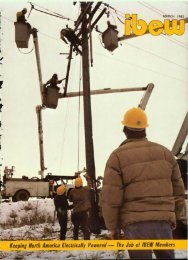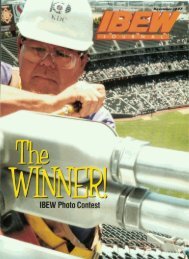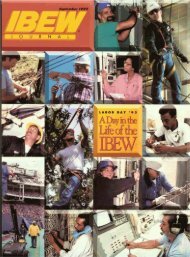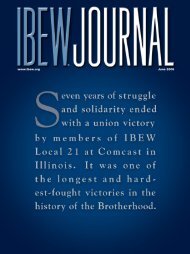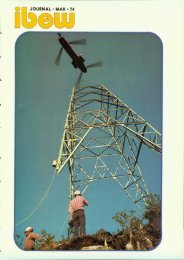1984-02 February IBEW Journal.pdf - International Brotherhood of ...
1984-02 February IBEW Journal.pdf - International Brotherhood of ...
1984-02 February IBEW Journal.pdf - International Brotherhood of ...
Create successful ePaper yourself
Turn your PDF publications into a flip-book with our unique Google optimized e-Paper software.
decided to flip a coin to determine the winners. In one council race. incumbent<br />
Glen Kanaga called the toss correctly to break the 698-698 deadlock he was in. A<br />
, 607-607 tie for a seat on the charter review commission was settled when Jonn!<br />
Clemett called the coin toss wrong. losing thereby to her opponent James<br />
, Mathewson. Some folks are going to read the above and say, "Yea, sure, but you're<br />
talking about piddling little <strong>of</strong>fices. I'm underwhelmed . Show me where one vote<br />
counts so much in a real important election." Well. to begin wi th, there's no such<br />
thing as a "piddling" <strong>of</strong>fice . They all count for something. In addi tion, some<br />
"real important elections" have been mighty close. Back in 1880, James Garfield<br />
~ just made it to the presidency over Winfield Hancock by a vote <strong>of</strong> 4,606,159 to<br />
4,604,261. That's a mere 1,898 votes out <strong>of</strong> 9,210.420 votes cast, a winning<br />
~ percentage <strong>of</strong> 50.01. John F. Kennedy fared much better . He defeated Richard Nixon<br />
in 1960 by an average <strong>of</strong> a little less than one vote per precinct nationwide.<br />
Nixon made it up eight years later . He topped Hubert Humphrey by merely two votes<br />
per precinct on average .<br />
... AFL-CIO Charges OSHA Report on Inspections Is Inflated<br />
The Occupational Safety & Health Administration is continuing its "pubic<br />
relations ploy" <strong>of</strong> showing inflated numbers on worksite inspections when the true<br />
measure <strong>of</strong> the agency's effectiveness--the number <strong>of</strong> workers covered--has declined<br />
_ by 45 percent since fiscal year 1980. Margaret Seminario, the AFL-CIO's job safety<br />
specialist, charged recently . In r'eleasing preliminary data for fiscal 1983, OSHA<br />
>. Administrator Thorne G. Auchter said his agency is "on track for making the<br />
j,. Ameri can workplace even safer and more healthful in coming years ...." He<br />
pointed out that federal inspectors had visited 68,577 work sites in FY 1983 and<br />
63,363 in FY 1980. Seminario, associate director <strong>of</strong> the AFL-CIO Dept . <strong>of</strong><br />
Occupational Safety, Health & Social Security, noted that 10.368 <strong>of</strong> the worksite<br />
inspections really were "records" inspections. Thus. the actual inspection total<br />
. is only 58,209, over 9 percent less than the FY 1980 figures. "The Reagan<br />
Admini stration is grandstanding and cheerleading. when an honest review <strong>of</strong> the<br />
inspection numbers shows there is nothing to cheer about." Seminario said . While<br />
OSHA touted its increased emphasis on construction site inspections, Seminario<br />
said this "artificially skews" the inspection figures because <strong>of</strong> the way OSHA<br />
counts those inspections . Each contractor or subcontractor at a job site is<br />
counted as an individual inspection, meaning fewer job sites have to be visited<br />
to "artificallly" increase the inspection total . The key to the agency's<br />
effectiveness, Seminario declared, is the number <strong>of</strong> workers covered by its<br />
inspections. That number has dropped more than 45 percent from 3.699,862 workers<br />
in FY 1980 to 2,032.358 in FY 1983, she pointed out. Nearly every figure relating<br />
to OSHA's inspection program has declined under the Reagan Administration.<br />
Manufacturing inspections are down 30 percent; maritime inspections, down 22<br />
percent ; follow-up inspections. down 86 percent. and worker complaints. down 51<br />
percent. she noted.<br />
Walter Mondale Sets Key Campaign Themes In Major Address Before Press<br />
Walter F . Mondale opened his <strong>1984</strong> campaign for the U.S. presidency by affirming<br />
.. his commi tment to liberal domestic goals and pledging to "take charge"--as<br />
. President--<strong>of</strong> the nation's foreign policy and reduce the risk <strong>of</strong> nuclear war.<br />
Kicking <strong>of</strong>f the oampaign year with an address to members <strong>of</strong> the National Press<br />
Club in Washington, Mondale dealt directly with criticism <strong>of</strong> his appeal for<br />
... support among broad-based groups labeled by the media as "speCial interests." Most<br />
prominent among these is the AFL-CIO, which has endorsed Mondale's candidacy for<br />
the Democratic presidential nomination . Mondale spelled out his own concerns--the<br />
"millions <strong>of</strong> unemployed who ought to have jobs," the millions <strong>of</strong> young people "who<br />
need a good education but are being denied it by the Reagan Administration," the<br />
-- need to turn around the Reagan Administration's "shameful record" <strong>of</strong> civil rights<br />
laws. protection <strong>of</strong> the environment, enactment <strong>of</strong> the Equal Rights Amendment, an<br />
all-out attack on hunger and poverty, and the use <strong>of</strong> defense and national strength<br />
"to keep the peace and ... reduce the risk <strong>of</strong> nuclear war . " He used the Press<br />
Club speech to project the key themes <strong>of</strong> his campaign-"a more competitive<br />
economy, a more just SOCiety, and a safer world"--and focused the bulk <strong>of</strong> his<br />
address on the last <strong>of</strong> the three .<br />
<strong>IBEW</strong> JOURNAL I FEBRUARV <strong>1984</strong> I 13


